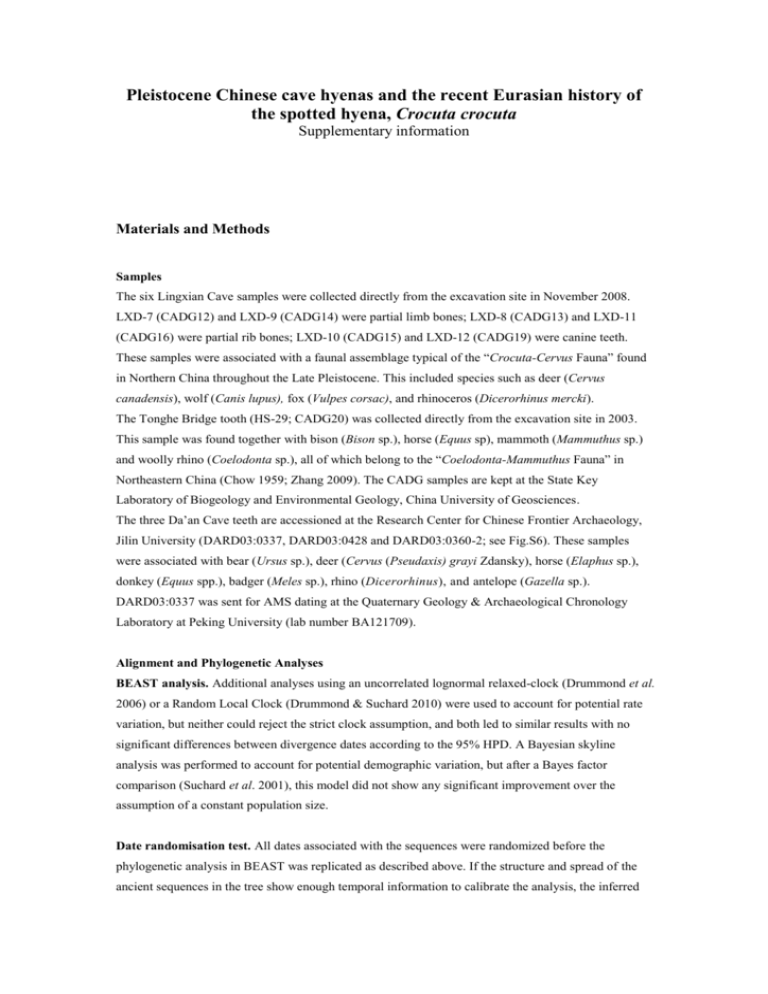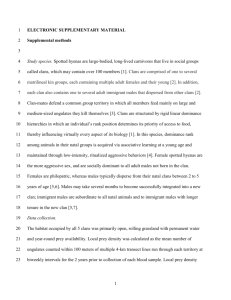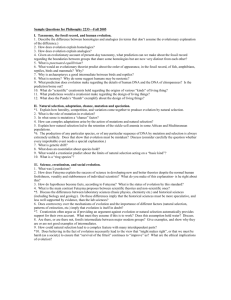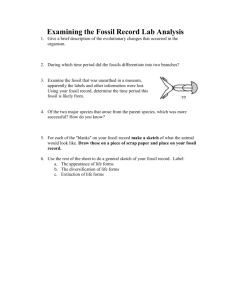mec12576-sup-0001-FigS1-S8-TableS1-S7
advertisement

Pleistocene Chinese cave hyenas and the recent Eurasian history of the spotted hyena, Crocuta crocuta Supplementary information Materials and Methods Samples The six Lingxian Cave samples were collected directly from the excavation site in November 2008. LXD-7 (CADG12) and LXD-9 (CADG14) were partial limb bones; LXD-8 (CADG13) and LXD-11 (CADG16) were partial rib bones; LXD-10 (CADG15) and LXD-12 (CADG19) were canine teeth. These samples were associated with a faunal assemblage typical of the “Crocuta-Cervus Fauna” found in Northern China throughout the Late Pleistocene. This included species such as deer (Cervus canadensis), wolf (Canis lupus), fox (Vulpes corsac), and rhinoceros (Dicerorhinus mercki). The Tonghe Bridge tooth (HS-29; CADG20) was collected directly from the excavation site in 2003. This sample was found together with bison (Bison sp.), horse (Equus sp), mammoth (Mammuthus sp.) and woolly rhino (Coelodonta sp.), all of which belong to the “Coelodonta-Mammuthus Fauna” in Northeastern China (Chow 1959; Zhang 2009). The CADG samples are kept at the State Key Laboratory of Biogeology and Environmental Geology, China University of Geosciences. The three Da’an Cave teeth are accessioned at the Research Center for Chinese Frontier Archaeology, Jilin University (DARD03:0337, DARD03:0428 and DARD03:0360-2; see Fig.S6). These samples were associated with bear (Ursus sp.), deer (Cervus (Pseudaxis) grayi Zdansky), horse (Elaphus sp.), donkey (Equus spp.), badger (Meles sp.), rhino (Dicerorhinus), and antelope (Gazella sp.). DARD03:0337 was sent for AMS dating at the Quaternary Geology & Archaeological Chronology Laboratory at Peking University (lab number BA121709). Alignment and Phylogenetic Analyses BEAST analysis. Additional analyses using an uncorrelated lognormal relaxed-clock (Drummond et al. 2006) or a Random Local Clock (Drummond & Suchard 2010) were used to account for potential rate variation, but neither could reject the strict clock assumption, and both led to similar results with no significant differences between divergence dates according to the 95% HPD. A Bayesian skyline analysis was performed to account for potential demographic variation, but after a Bayes factor comparison (Suchard et al. 2001), this model did not show any significant improvement over the assumption of a constant population size. Date randomisation test. All dates associated with the sequences were randomized before the phylogenetic analysis in BEAST was replicated as described above. If the structure and spread of the ancient sequences in the tree show enough temporal information to calibrate the analysis, the inferred mean rate calculated using the correct association date/sequence should be significantly different from the 95% HPD rate estimates calculated from the randomized data set. A comparison of resulting rate estimates from ten replicates and the non-randomized data are shown in Fig.S4. Methods: Sequence replication Teeth samples were extracted using a Qiagen Blood & Tissue Kit (Valencia, California) using a modified protocol with added EDTA and Proteinase K (Thomson et al., in preparation). PCR amplifications were carried out in 25μL volumes, using 1x of PCR buffer, 2.5 mM of MgSO4, 1 mg/mL of rabbit serum albumin (RSA), 0.2 M of each primer, 0.25 mM of dNTPs, 1 U of Platinum HiFi Taq (Invitrogen) and 2 μL of ancient DNA extract. Cycling conditions were: 94ºC for 2 min; 50 cycles of 94ºC for 15 s, 54ºC for 30 s, and 68ºC for 20 s; 68ºC for 10 min. PCR products were visualized under UV light on a 3.5% agarose gel stained with ethidium bromide. Successful amplifications were purified using Ampure (Agencourt) according to manufacturer’s instructions and both strands were sequenced directly using Big Dye chemistry and an ABI 3130XL Genetic Analyzer (Applied Biosystems). Bayes Factor calculation The Bayes factor of the two divergence models given the fossil dates (earliest appearance of C. crocuta in China and the estimated time of arrival of cave hyena in western Eurasia) was calculated empirically from the BEAST estimates of the two basal nodes using the following formulae: where BF12 is the Bayes Factor of model 1 compared to model 2, M1 is the tip calibrated model, M2 is the fossil calibrated model, D is the paleontological data, Tij is the estimate of the paleontological date i with model j, and assuming equal priors for M1 and M2. Each of the numerator and denominator (i.e. the probability of each model given the data) was calculated empirically using the area under the curve of the posterior distribution of each basal node, such that: where area 1 is the area under the curve of the posterior distribution of basal node 1 (older node) less than the paleontological date 1 (230,000 - 400,000 ya BP), area 2 is the area under the curve of the posterior distribution of basal node 2 (younger node) less than the paleontological date 2 (< 300,000 ya BP), and the total area is the sum of the total areas under each posterior distribution. These calculations were performed in R (R development core team 2011) using the approxfun function to describe the posterior distribution of the two basal nodes from the BEAST analyses, and the integrate function to estimate the area under the curves. Hypothesis testing. Hypothesis testing of each model against the paleontological fossil dates was also used to evaluate the statistical support for each model separately. In each case, the null hypothesis was that the paleontological fossil dates stem from the same population history as the posterior distribution of dates for each node (calculated in BEAST using the appropriate calibration model). The alternate hypothesis is that the paleontological fossil dates do not stem from the same population history as the posterior distribution of dates for each node. The posterior distributions for the tip calibration model were transformed using the natural logarithm as both nodes were positively skewed (i.e. not normally distributed). Each posterior distribution was then scaled to a mean of zero and standard deviation of 1; the z-score was calculated to estimate the number of standard deviations the paleontological fossil dates were away from the mean of the posterior distribution; and the z-score was translated into a p-value (Table S4) using R (R development core team 2011). Serial Coalescent Simulations. Bayesian Serial Simcoal (BayeSSC; Anderson et al. 2004) was used to simulate datasets under two divergence models, one proposed by Rohland et al. (2005) using fossil calibrations, and the other proposed in this study using tip dated ancient DNA samples. Four different mutation rate estimates were used in the simulations: two constant mutation rates calculated from BEAST analyses (using fossil calibrations as per Rohland et al. (2005) and the tip date calibrations in this study), and two time dependent mutation rates (using linear and exponential decay equations). Summary statistics from the twelve simulated datasets (three models by four mutation rates) were compared to those of the genetic dataset generated in this study, using Akaike Information Criterion (AIC) values to compare the likelihood of each model (Figure S6 and Table S5). Summary Statistics. For each simulated dataset we calculated 30 summary statistics, namely two measures of population differentiation between each pair of clades (FST and private alleles between each of clades A1, A2, B, C and D). All of the observed summary statistics from the dataset generated in the present study were calculated using the SCStat.exe program (Anderson pers comm.) to ensure comparable methods of generating FST; BayeSSC calculates FST using the formula of Hudson et al. (1992), whereas Arlequin uses the standard formula of Wright (1951). Simulation parameters. BayeSSC was used to generate 10,000,000 simulations under each of the eight models with divergence events, with 500,000 simulations generated for each of the four panmictic models. The panmictic models differed from the other eight in that no divergence events were modelled, while the divergence models differed in terms of the prior distributions on divergence order/times between clades. The Rohland et al. (2005) model proposed that the node containing all clade A1 (Eurasian Pleistocene and modern samples) samples within clade A occurred 0.36 million years ago (Ma), clades A-C diverged 1.3 – 1.5 Ma, and all other clades diverged from clade D 3.48 Ma BP (2.25 – 5.09 Ma BP). Using the hyena generation time of 5.7 years (Watts et al. 2011), each of these events was converted from years to generations and given a normal distribution as prior. The Rohland et al. (2005) divergence model was given a divergence prior for clades A1/A2 of 63,158 ± 8,500 generations (mean ± standard deviation), a divergence prior for clades A/B and A/C of 245,614 ± 45,000 and 245,615 ± 45,000 generations respectively, and a divergence prior for all other clades from clade D of 614,035 ± 95,000 generations ago. In contrast, the BEAST analysis using the tip calibration dates in the present study estimates that clades A1/A2 diverged 15,614 ± 1,200 generations ago, clades B/C diverged 28,596 ± 2,000 generations ago, clades A/B/C diverged 39,298 ± 2,000 generations ago, and clades A/B/C/D diverged 75,439 ± 10,000 generations ago. Each of the prior standard deviations was narrowed to ensure that no divergence event overlapped with any other, to ensure coalescence of lineages occurred. Parameters common to all divergence models include modern effective population size (1000 per clade), growth rate (constant population size), and migration (no migration). Parameters common to all panmictic models include modern effective population size (5000), while the growth rate ranged from an ancient effective population size of 1000 to a modern effective population size of 5000 over a similar timescale to the divergence of the basal node for each mutation rate/model (2 Ma for internal calibrated model; 2.5 Ma for external calibrated model; 2 Ma for time dependent linear decay; and 6 Ma for time dependent exponential decay; see Fig. S7). Mutation Parameters. The simulations were based on the current dataset of 366bp of mitochondrial DNA sequence data, with a transition/transversion ratio of 0.956522. The gamma shape parameter of 483 with 4 rate categories was used for the simulations using the constant mutation rate from tip dates, as well as all the time dependent mutation rate classes (as calculated from the tip dated BEAST analysis). The simulations for the fossil calibrated constant mutation rate used a gamma shape parameter of 325 with 4 rate categories (as calculated from the fossil calibrated BEAST analysis). The constant mutation rates were converted from that estimated in the BEAST analysis (in substitutions/site/year) to the units used in BayeSSC (in substitutions/sequence length/generation) using the sequence length of 366 base pairs and the generation time of 5.7 years (Watts et al. 2011). Equations were written for each of the time dependent mutation rates using the constant mutation rates above as point estimates (Table S6 and Figure S8). Approximate Bayesian Computation. For all the observed measures of population differentiation, we retained the closest 0.1% of the simulations using the reject function (available at http://www.stanford.edu/group/hadlylab/ssc/eval.r), and further estimated the maximum likelihood estimator (MLE) for each parameter for the divergence models. The MLEs were input into BayeSSC as priors for a second round of 10,000 simulations in order to generate AIC values using the aic.ssc function (also available at http://www.stanford.edu/group/hadlylab/ssc/eval.r). The panmictic models had the closest 0.1% of the simulations retained using the reject function, with AIC values generated directly from the 500,000 simulations using the aic.ssc function, as the parameters did not have a prior distribution to be estimated (i.e. the parameters were either constant (growth rate) or time dependent (mutation rate)). The aic.ssc function was chosen to evaluate the different analyses, as AIC values are the best way to compare models accounting for the differing number of parameters (i.e., the timedependent mutation rate class of models had one additional prior over the constant rate class of models). The AIC values were converted to AICc (second order AIC values, which are more appropriate for small sample sizes), with the delta AIC and Akaike weights calculated to provide measures of strength of evidence for each model. The best or preferred model is that with the lowest AIC value. Delta AIC values were generated between the best model and each of the other models as a measure of the strength for the best model, with delta AIC values <2 providing substantial support for the other model, delta AIC values 3 - 7 indicate the other model has considerably less support, and delta AIC values > 10 show the other model is very unlikely. Akaike weights provide an additional measure of strength for each model and represent the relative support that each model has out of all candidate models tested. Results and discussion. Model comparison. The Bayes Factor of M1 (using tip calibrations) compared to M2 (using fossil calibrations) was calculated as 872 (BF <1 supports M2; 1 < BF < 3 provides support for M1 that is barely worth mentioning; 3 < BF < 10 provides substantial support for M 1; 10 < BF < 30 provides strong support for M1; 30 < BF < 100 provides very strong support for M1; and BF > 100 provides decisive support for M1). Therefore, we find decisive evidence that the tip calibration model is more strongly supported by the paleontological data under consideration than the fossil calibration model of Rohland et al. (2005). Hypothesis testing. Evaluating the external (fossil dated) calibration model of Rohland et al. (2005) against: basal node 1 (older node, 400-230 thousand years ago (ka)) yielded a p-value of 0.003; and against basal node 2 (younger node, < 300 ka) yielded a p-value of 0.021. These results are significant at the 5% level (i.e. there is evidence against the null hypothesis that the paleontological fossil dates stem from the same population history as the fossil calibrated nodes). In contrast, the internal (tip dated) calibration model proposed in this study compared to basal node 1 yielded a p-value of 0.653, and compared to basal node 2 yielded a p-value of 0.337, indicating there is no evidence against the null hypothesis (i.e., there is no evidence against the null hypothesis that the paleontological fossil dates stem from the same population history as the tip calibrated nodes). Serial Coalescent Simulations The model with the lowest AIC/AICc values was the model of population differentiation proposed in the present study, with a time dependent mutation rate that followed a linear decay. The preferred model proposes that clade D diverged from clades A/B/C 225 ka BP, which fits with the fossil record in China where the earliest C. crocuta ultima specimen was found which dates to 400-230 ka BP (Turner 1990; Qiu et al. 2004; Zhou et al. 2000). Clades B/C diverged from clade A 186 ka BP, clade B diverged from clade C 127 ka BP, and clade A1 and A2 diverged from each other only 64 ka BP. The combination of this model and the time dependent linear decay mutation rate has a 99.93% chance of being the best model amongst those considered in this set of twelve candidate models (Table S5). Russia Russia Mongolia Mongolia China China Fig. S1. Geographic distribution of fossil spotted hyenas in Far East Asia, showing Pleistocene hyena fossil sites in China. Empty red triangles: Late Pleistocene C. crocuta ultima hyenas; empty Fig. S1. Geographic distribution of fossil spotted hyenas in Far East Asia, showing Pleistocene green triangles: Mid Pleistocene C. crocuta ultima hyenas; filled red triangles: samples sequenced in hyena fossil sites in China. Empty red triangles: Late Pleistocene C. crocuta ultima hyenas; empty this study; filled red circle: samples reported in Rohland et al. (2005). green triangles: Mid Pleistocene C. crocuta ultima hyenas. (a) 713 38 750 1140 CrR1l CrF1 CrF3 CrR3 Cb1H Cb1L Cb3H Cb5L Cb3L Cb5H (b) CrR2 CrF2 (c) 20 98 CrF4 12 93 Cb2L 14 100 53 121 CrR4 Cb2H 20 85 20 116 Cb4L Cb4H 16 90 38 89 113 Fig. S2. Schematic view of the 713 bp configs of the cyt b gene for the Pleistocene samples using Fig. S2. Schematic view of the 713 bp configs of the cyt b gene for the Pleistocene samples using nine overlapping PCR fragments. (a) Beginning and ending nucleotide positions of the 713 bp contigs in the 1140 bp complete cyt (a) b gene; (b) Primer bindingnucleotide areas of nine primerof pairs; (c) Nine nine overlapping PCR fragments. Beginning and ending positions the 713 bp overlapping fragments, numbers below fragments show length of the amplification products without contigs in the 1140 bp complete cyt b gene; (b) Primer binding areas of nine primer pairs; (c) Nine primers, numbers above fragments show overlaps between individual fragments. overlapping fragments, numbers below fragments show length of the amplification products without primers, numbers above fragments show overlaps between individual fragments. Fig. S3. Phylogenetic tree for fossil and extant spotted hyenas from the 366bp dataset, using the striped hyena as an outgroup and calibration of 9-9.5 Ma for the divergence between Crocuta lineage and Hyaena/Parahyaena lineage, in addition to the tip calibrations from the dates of ancient samples. (a) (b) 1e− 07 2E7 1.75E7 1e− 09 1.5E7 1e− 11 Rate (s/s/y) tMRCA (years) 1.25E7 10000000 95% HPD: 5.12E4 - 1.78E7 1.33E5 - 8.47E5 7500000 5000000 1e− 13 2500000 Iterations 0 Prior only With data Fig. S4. Different tests showing temporal signal in the datasets. (a) Date Randomization Test. Red circle and dotted line represent the mean rate calculated during the phylogenetic analysis of the 366bp alignment of spotted hyenas using the radiocarbon dates associated with the ancient sequences as calibration. The grey lines represent the 95% HPD of rates calculated for ten replicates of the same analysis with randomized dates. The fact that none of these margins overlap with the original mean rate demonstrates that the radiocarbon dates used for this study is informative enough to calibrate the timed phylogeny. (b) BEAST run with priors only. Comparison of the tMRCA of spotted hyena calculated from BEAST with and without the data, to investigate the influence of the priors on the results. This comparison shows that the tMRCA inferred in this study is not driven by the priors only, but is a result of the phylogenetic signal from the genetic data combined with the calibration dates. Fig. S5. Comparison of rates (a) and dates (b) estimates with 2 calibration dates for the Chinese samples. Marginal posterior densities of the inferred molecular rates and the two basal nodes of the calculated for phylogeny ten replicates of the from sameBEAST analysisanalyses, with randomized dates. factkathat none of these spotted hyena reported using either theThe 35.52 direct AMS dating margins overlap with the original mean rate demonstrates that the radiocarbon dates used for this study of DARD-1 or the 34.37 ka proxy date from the associated deer bone as a calibration for all three is informative enough to calibrate the timed phylogeny. Chinese samples (DARD-1, 2 and 3). Fig.S5 Photos of three Da’an Cave specimens. DARD03:0337, DARD03:0428, and DARD03:0360 Fig.the S6.excavation Photos ofno. three Da’an Cavewhich specimens. DARD03:0337, DARD03:0428, and DARD03:0360 are of the samples, have been named DARD-1, DARD-2, and DARD-3 in Table respectively. are theS2, excavation no. of the samples, which have been named DARD-1, DARD-2, and DARD-3 in Table S2, respectively. The photos were taken before the tips were removed for DNA extraction. Fig. S7. Posterior maximum likelihood estimators output from BayeSSC. The AIC values calculated for each of the twelve model/rate combinations are noted, with the best model indicated in grey with the AIC value asterixed* (Model H). The branching order of some populations in Models K and L are reversed due to the way in which divergence events are described in BayeSSC (i.e. 100% of population 1 migrates into population 2 backwards in time). Fig. S8. Graph of time dependent mutation rate, showing (a) linear and (b) exponential decay relationships between the two calibration points. The youngest calibration point signifies tip dates from radiocarbon dated ancient bone samples (11 samples which average to 7,522 generations ago, or 42,877 ya BP), and has a BEAST calculated mutation rate of 1.83 x 10-4 subs/seq/gens (or 8.8 x 10-8 subs/site/yr). The oldest calibration point uses fossil dates to estimate the basal node on a phylogenetic tree at 1,754,385 generations ago (or approximately 10 Ma BP), with a BEAST calculated mutation rate of 0.19 x 10-4 subs/seq/gens (or 9.34 x 10-9 subs/site/yr). The equation for the linear relationship is: 1.83x10-4 – (9.39x10-11 x [T]) and the equation for the exponential decay relationship is: 1.85x10 -4 x 0.999998 [T]. Table S1. PCR primers for Crocuta crocuta ultima mitochondrial cytochrome b gene Table S2. Details on sequences used in this study No. in this study DARD-1 DARD03:0337 DARD-2 DARD03:0428 DARD-3 DARD03:0360-2 C.crocuta_Belgium C.crocuta_Russia C.crocuta_Austria1 C.crocuta_Austria2 C.crocuta_Czech Rep C.crocuta_North Sea C.crocuta_Romania C.crocuta_France C.crocuta_Ukraine C.crocuta_Altai C.crocuta_Slovalia C.crocuta_Germany1 C.crocuta_Germany2 C.crocuta_Hungary C.crocuta_Senegal C.crocuta_Ethiopial C.crocuta_Cameroon C.crocuta_Togo C.crocuta_Tanzania C.crocuta_Rwanda C.crocuta_Eritrea C.crocuta_Sudan C.crocuta_Zimbabwe C.crocuta_Namibia GenBank Length Accesion No. Species C14 age (ka) Crocuta crocuta ultima 35.52±0.23 KC117379 Crocuta crocuta ultima ~35.52±0.23 Crocuta crocuta ultima ~35.52±0.23 Crocuta crocuta spelaea N/A Crocuta crocuta spelaea 48.65+2.38/-1.84 Crocuta crocuta spelaea 38.06±0.85 Crocuta crocuta spelaea 38.68±0.92 Crocuta crocuta spelaea 46.0±2.1 Crocuta crocuta spelaea N/A Crocuta crocuta spelaea 41.8+1.4/-1.2 Crocuta crocuta spelaea 40.7±0.9 Crocuta crocuta spelaea 41.3±1.2 Crocuta crocuta spelaea 42.3+0.94/-0.84 Crocuta crocuta spelaea 51.2+4.9/-3.0 Crocuta crocuta spelaea N/A Crocuta crocuta spelaea N/A Crocuta crocuta spelaea 41.8±1.3 Crocuta crocuta modern Crocuta crocuta modern Crocuta crocuta modern Crocuta crocuta modern Crocuta crocuta modern Crocuta crocuta modern Crocuta crocuta modern Crocuta crocuta modern Crocuta crocuta modern Crocuta crocuta modern Location Reference 713 bp China This study KC117380 713 bp China This study KC117381 713 bp China This study DQ157554 DQ157555 AJ809318 AJ809320 AJ809321 AJ809323 AJ809324 AJ809325 AJ809326 AJ809327 AJ809328 AJ809329 AJ809330 AJ809331 DQ157556 DQ157557 DQ157558 DQ157559 DQ157560 DQ157562 DQ157564 DQ157565 DQ157566 DQ157568 366 bp 366 bp 366 bp 366 bp 366 bp 366 bp 366 bp 366 bp 366 bp 366 bp 366 bp 366 bp 366 bp 366 bp 366 bp 366 bp 366 bp 366 bp 366 bp 366 bp 366 bp 366 bp 366 bp 366 bp Belgium Russia Teufelsucke Austria Winden, Austria Czech Rep. The Netherlands Romania France Ukraine Russia Slovakia Germany Germany Hungary Senegal Ethiopial Cameroon Togo Tanzania NE-Rwanda Eritrea Sudan Zimbabwe Namibia 1 1 2 2 2 2 2 2 2 2 2 2 2 2 1 1 1 1 1 1 1 1 1 1 C.crocuta_South Africa Crocuta crocuta modern DQ157569 366 bp South Africa 1 C.crocuta_Angola C.crocuta_Somalia C.crocuta_Kenya C.crocuta_Uganda C.crocuta_zoo1 C.crocuta_zoo2 C.crocuta_zoo3 C.crocuta_zoo4 H.hyaena H.hyaena P.brunnea P.brunnea P.cristatus P.cristatus Crocuta crocuta Crocuta crocuta Crocuta crocuta Crocuta crocuta Crocuta crocuta Crocuta crocuta Crocuta crocuta Crocuta crocuta Hyaena hyaena Hyaena hyaena Parahyaena brunnea Parahyaena brunnea Proteles cristatus Proteles cristatus modern modern modern modern modern modern modern modern modern modern modern modern modern modern DQ157570 DQ157571 DQ157572 DQ157574 AY048786 AF511064 AY170114 AY928676 AY928678 AY048787 AY048790 AY928677 AY048791 AY048792 366 bp 366 bp 366 bp 366 bp 1137 bp 1140 bp 1140 bp 1140 bp 1140 bp 1137bp 1137bp 1140bp 1137bp 1137bp Angola Somalia Kenya Uganda N/A N/A N/A N/A N/A N/A N/A N/A N/A N/A 1 1 1 1 3 4 5 6 6 3 3 6 3 3 P.cristatus Proteles cristatus modern AY928675 1140bp N/A 6 Table S3. Variations in the newly obtained ancient sequences compared to living spotted hyenas Four spotted hyena Cyt b sequences (Accession Nos: AY048786, AY928786, AY170114, and AF511064) available in GenBank. The large majority of the variable positions in the Pleistocene fossil spotted hyenas were transitions, with only two transversions (A→T at nucleotide position 258 and T→A at nucleotide position 712). Moreover, 19.4%, 10.2%, and 69.4% of the polymorphic sites were 40 46 84 90 96 102 109 124 144 153 179 204 219 243 245 258 261 264 291 321 336 342 358 387 390 393 396 402 426 438 468 474 478 495 503 513 565 574 577 578 648 657 669 705 707 709 712 found at 1st, 2nd, and 3rd codon positions, respectively. AY048786 AY928676 AY170114 AF511064 DARD-1 DARD-2 A . . G G G A . . G . . A G G . . . A G G . . . T . . . C C G . . . A A C T T T . . G A A A A A C T T T . . A . . . G G C . . . T T C . . . T T T A A A . . C . . . T T T . . . C C A . . . T T T . . . C C C . . . T T C T T T T T T C C C C C G . . . A A T C C C C C C . . . T T G A A A . . T . . . C C T . . . C C C . . . T T G A A A A A T . . . C C T . . C . C C . . . T T C T T T . . T C C C C C A . . . G G T . . C . . T . . . C C G A A A . . C . . G . . G . . . A A T C C C C C C . . . T T A . . . G G C . . . T T G . . . A A T . . . C C C T T T . . T A A A A A DARD-3 G . . . C A . A . G T T . T C T C T T C A C T . C C T A C . T . C G . C . . A . T T T A C . A is no evidence against the null hypothesis that the paleontological fossil dates stem from the same population history as the tip calibrated nodes). ' Table'S4'Probability'of'observing'the'paleontological'fossil'dates'under'the'null' Table S4. Probability of observing the paleontological fossil dates under the null hypothesis that hypothesis'that'the'posterior'distribution'of'the'basal'nodes'are'either'the'externally' the posterior distribution of the basal nodes are either the externally (Miocene fossil dated) (fossil'dated)'calibration'model'or'the'internally'(tip'dated)'calibration'model.'' calibration model or the internally (AMS radiocarbon tip dated) calibration model. Paleontological fossil date Old fossil date between 400-230 kya Young fossil date (<300 kya) Old fossil date between 400-230 kya Young fossil date (<300 kya) Model Fossil calibration Fossil calibration Tip calibration Tip calibration P-value 0.003 0.021 0.653 0.337 Serial Coalescent Simulations The model with the lowest AIC/AICc values was the model of population differentiation proposed in the present study, with a time dependent mutation rate that followed a linear decay. The preferred model proposes that clade D diverged from clades A/B/C 225 kya BP, which fits with the fossil record in China where the earliest C. crocuta ultima specimen was found which dates to 400-230 kya BP (1517). Clades B/C diverged from clade A 186 kya BP, clade B diverged from clade C 127 kya BP, and clade A1 and A2 diverged from each other only 64 kya BP. The combination of this model and the time dependent linear decay mutation rate has a 99.93% chance of being the best model amongst those considered in this set of eight candidate models (Table S5). Table S5. Akaike Information Criterion (AIC) values for the twelve different model/mutation rate combinations. Method of rate calc. Model P # Ln Li Li AIC AICc Delta AICc Relative model likelihoods Akaike weights (wi) H0 (A) 1 -337.09 4.01x10-147 338.09 676.31 157.80 5.41x10-35 0.0000 Tip dates H1 (B) 4 -278.94 7.19x10-122 282.94 567.26 48.76 2.58x10-11 0.0000 H2 (C) 4 -262.90 6.67x10-115 266.90 535.18 16.68 2.39x10-04 0.0002 H0 (D) 1 -528.76 2.31x10-230 529.76 1059.64 541.14 3.12x10-118 0.0000 Fossil H1 (E) 4 -427.52 2.15x10-186 431.52 864.41 345.91 7.70x10-76 0.0000 dates H2 (F) 4 Infinity -146 H0 (G) 2 -335.69 1.63x10 337.69 675.76 157.26 7.10x10-35 0.0000 TD linear H1* (H) 5 -253.18 1.11x10-110 258.18 518.50 0.00 1 0.9993 H2 (I) 5 Infinity H0 (J) 2 -341.40 5.40x10-149 343.40 687.19 168.68 2.35x10-37 0.0000 TD_expo H1 (K) 5 -261.95 1.72x10-114 266.95 536.05 17.54 1.55x10-04 0.0002 H2 (L) 5 -261.39 3.02x10-114 266.39 534.92 16.42 2.72x10-04 0.0003 * Line highlighted in grey represents the model with lowest AIC value – best model; TD – Time dependent mutation rate; Expo – exponential decay equation describes the decreasing mutation rate with increasing time since the present day; H0 – panmixia model rejected by Rohland et al. (2005) and shown in Fig. S7A, D, G, J; H1 – model proposed in the present study and shown in Fig. S7B, E, H, K; H2 – model proposed in Rohland et al. (2005) and shown in Fig. S7C, F, I, L; P# - number of parameters extimated in BayeSSC; Li – Likelihood of the model; Ln Li – Natural logarithm of the likelihood of the model; AIC – Akaike Information Criterion; AICc – second order Akaike Information Criterion; Delta AICc – difference between the AICc of each model compared to the best model. Table S6. Maximum Likelihood Estimators (MLE) with lower (2.5%) and upper (97.5%) confidence bounds for divergence times from the Bayesian Serial Simcoal (BayeSSC) analysis (for divergence models only – H1 and H2). Split between A1 & A2 Split between B & C Split between A2 & C Split between C and D 2.5% MLE 97.5% 2.5% MLE 97.5% 2.5% MLE 97.5% 2.5% MLE 97.5% Demographic model proposed in this paper – H1 Constant mutation rate: based on tip 59,577 72,739 115,715 115,287 129,506 204,436 185,441 186,272 257,743 261,527 565,921 609,963 dates Constant mutation rate: based on 63,024 62,699 114,357 121,448 121,427 204,663 185,606 184,859 259,154 280,652 639,463 640,747 fossil dates Time dependent mutation rate: linear 63,226 63,774 111,345 123,206 127,599 202,253 183,982 186,254 260,668 226,888 225,792 663,071 decay Time dependent mutation rate: 64,644 67,990 111,116 124,287 209,426 209,497 182,570 189,765 266,983 232,302 651,151 645,110 exponential decay Demographic model of Rohland et al. (2005) – H2 Constant mutation rate: based on tip 161,025 182,730 476,673 397,740 431,755 2,267,223 199,416 442,537 1,850,296 1,503,967 1,613,764 5,233,553 dates Constant mutation rate: based on 194,145 196,106 526,087 558,036 609,659 2,178,957 471,872 648,565 2,241,066 1,816,061 1,982,040 5,323,330 fossil dates Time dependent mutation rate: linear 143,180 177,202 445,294 282,382 365,218 2,082,622 247,830 400,721 1,801,559 1,443,440 1,543,733 5,208,712 decay Time dependent mutation rate: 159,092 172,986 452,070 339,612 469,850 2,238,376 286,378 439,309 2,013,735 1,350,090 5,284,195 5,305,761 exponential decay Line highlighted in grey represents the model and mutation rate with lowest AIC (i.e. the more likely of the models). Values in italix represent a reversal in branching order from the other versions of this model, resulting from the way BayeSSC requires divergence events to be described (i.e. 100% of individuals from population C migrating backwards in time to population A2 prior to 100% of individuals from population C migrating backwards in time to population B). Table S7. Mutation rates used in the BayeSSC analysis, and the method used to calculate the time dependent mutation rates. Rate at Rate at 7,522 1,754,385 generations generations -4 Tip dates (this study) Constant 1.836 x 10 1.836 x 10-4 -4 Fossil calibrations (4) Constant 0.195 x 10 0.195 x 10-4 -4 -11 -4 Time dependent – linear 1.83x10 – (9.39x10 x [T]) 0.195 x 10 1.836 x 10-4 -4 [T] -4 Time dependent - exponential 1.85x10 x (0.999998 ) 0.195 x 10 1.836 x 10-4 [T] – Number of generations back in time as lineages coalesce, i.e. for each generation simulated from the present back in time, the value of [T] increases by 1. The rate at 7522 generations (42,877 ya BP) equates to the average of the tip dates across the tree. The rate at 1,754,385 generations (10 Mya BP) equates to the fossil calibration of the basal node used in Rohland et al. (2005). Method of rate calculation Mutation rate description Reference: Anderson CNK, Ramakrishnan U, Chan YL, Hadly EA (2004). Serial SimCoal: A population genetics model for data from multiple populations and points in time. Bioinformatics, 21, 1733-1734. Chow MC (1959) Age of the mammalian fossil assemblages. In: Pleistocene Mammalian Fossils from the Northeastern Provinces (ed. The Paleomammalogy Group of IVPP). Memoirs of Institute of Vertebrate Paleontology and Paleoanthropology Academia Sinica, No. 3 pp. 9-10 (in Chinese with English summary). Drummond AJ, Ho SYW, Phillips MJ, Rambaut A (2006) Relaxed phylogenetics and dating with confidence. PLoS Biology, 4, 699-710. Drummond AJ, Suchard MA (2010) Bayesian random local clocks, or one rate to rule them all. BMC Biology, 8, 114. Hudson RR, Slatkin M, Maddison WP (1992) Estimation of levels of gene flow from DNA sequence data. Genetics, 132, 583-589. Qiu ZX, Deng T, Wang BY (2004) Early Pleistocene mammalian fauna from Longdan, Dongxiang, Gansu, China. Palaeontologia Sinica, Series C, 27, 1-198. R development core team (2011) R: A language and environment for statistical computing. (R foundation for statistical computing, Retrieved from http://www.r-project.org). Rohland N, Pollack J L, Nagel D et al. (2005) The population history of extant and extinct hyenas. Molecular Biology and Evolution, 22, 2435-2443. Suchard MA, Weiss RE, Sinsheimer JS (2001) Bayesian selection of continuous-time Markov Chain Evolutionary models. Molecular Biology and Evolution, 18, 1001-1013. Turner, A (1990) The evolution of the guild of larger terrestrial carnivores during the Plio-Pleistocene in Africa. Geobios, 23, 349-368. Watts HE, Scribner KT, Garcia HA, Holekamp KE (2011) Genetic diversity and structure in two spotted hyena populations reflects social organization and male dispersal. Journal of Zoology, 285, 281-291. Wright S (1951) The genetical structure of populations. Annals of Eugenics, 15, 323-354. Zhang HC (2009) A Review of the Study of Environmental Changes and Extinction of the Mammuthus-Colelodonta Fauna during the Middle-late Late Pleistocene in NE China. Advances in Earth Science, 24, 49-60. Zhou C, Lui Z, Wang Y (2000) Climatic cycles investigated by sediment analysis in Peking Man’s Cave, Zhoukoudian, China. Journal of Archaeological Science, 27, 101-109.








